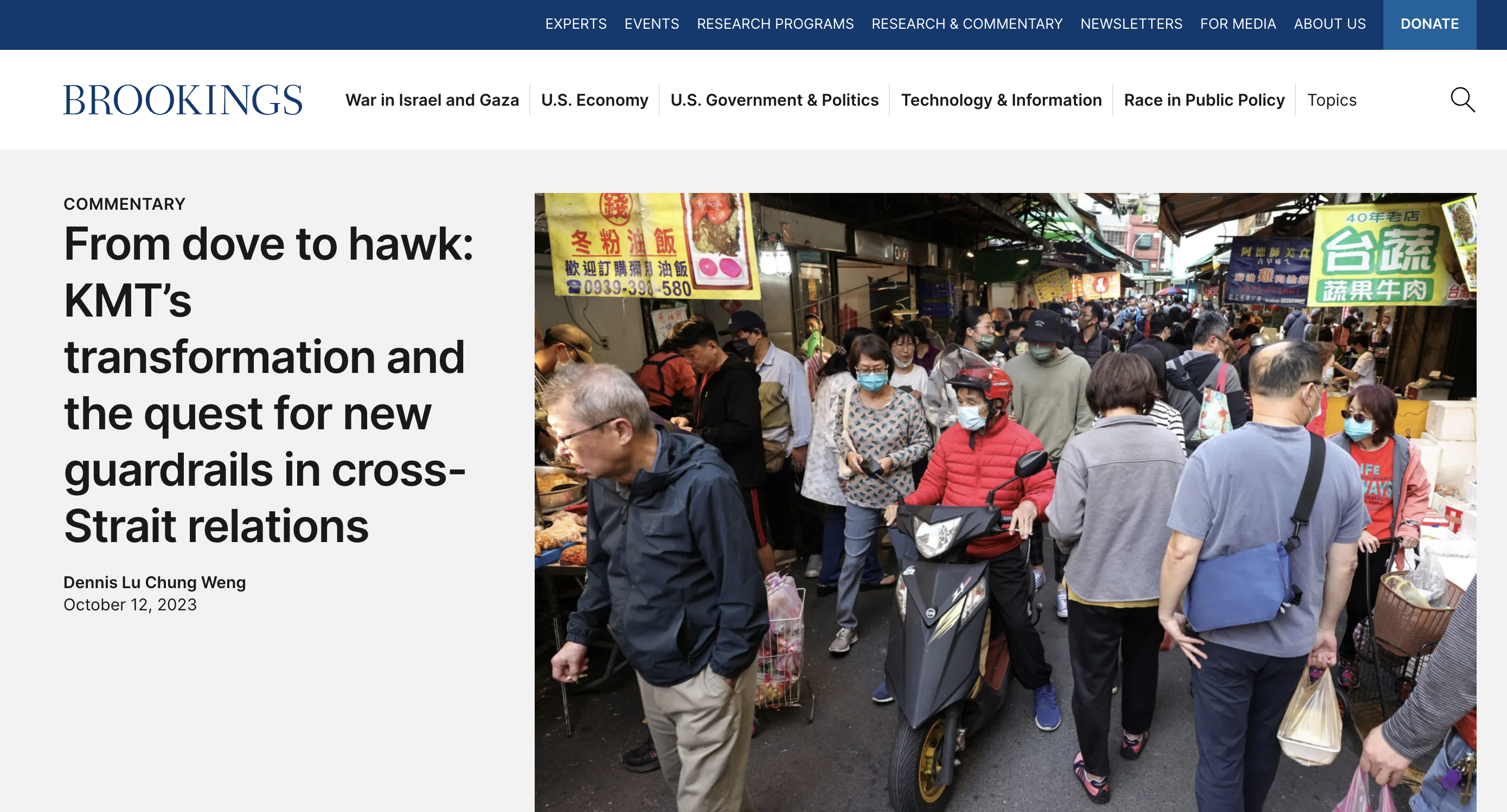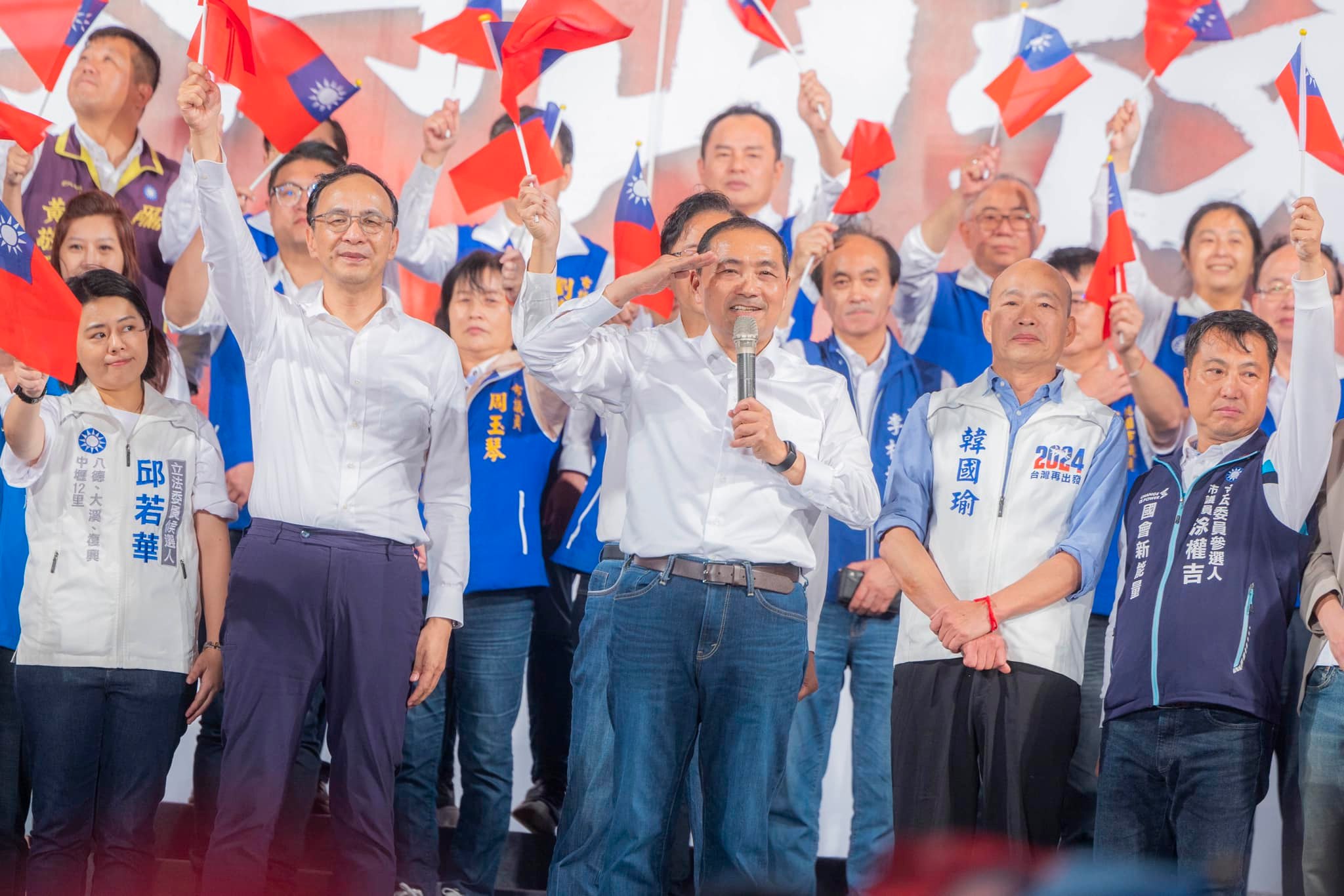by Brian Hioe
語言:
English
Photo credit: KMT/Facebook
A RECENT ARTICLE on the Brookings Institution titled “From dove to hawk: KMT’s transformation and the quest for new guardrails in cross-Strait relations”, by Dennis Lu Chung Weng, proves a strange exercise in the KMT’s attempts to depict itself in a positive light to the US. Seeing as the article appeared in the same timeframe as an article by former Sunflower Movement student leader Lin Fei-fan, this seems to be the Brookings Institution’s attempt to present the KMT’s viewpoint.
In particular, the article makes a number of bizarre claims, including asserting that the KMT has shifted from a pro-unification stance to one that is now “hawkish” on China. Likewise, the article asserts that the KMT has embraced contemporary Taiwanese civic nationalism, citing identity polling to this effect from Duke University and National Cheng Chi University.

The article in question
It proves a rather odd argument claiming that the KMT is now hawkish on China. In the past election cycle, the KMT has sought to frame itself as the party of “peace” while framing the DPP as the party of “war”. The suggestion is that the DPP provokes China because of its ideological obstinacy on Taiwanese independence, never mind that the DPP has long since backed away from such views and moved toward a pro-status quo position. Nevertheless, this is used to try and create the perception that it is because the DPP holds power that China threatens Taiwan militarily, and that with the KMT back in power, Chinese threats will cease.
In this way, Lu’s claims do not mesh with the actual rhetoric of the KMT. However, this is clearly the face that the KMT seems to wish to present to the US at present.
The 2014 Sunflower Movement represented the high point of youth backlash against the KMT in the past decade. Two years ago, the KMT had less than 9,000 members under 40, though the party claims that recruitment of under-40s is up by 40% in the two years since then. Young people feel alienated from the party because of its perceived pro-China stances, hence why successive KMT leaders have attempted–mostly unsuccessfully–to change the image of the party.
The KMT’s inability to draw young people into the fold is thought to correspond to identity trends indicating rising Taiwanese identity and declining Chinese identity, as well as declining mutual Taiwanese and Chinese identity. By contrast, the upsurge in Taiwanese identity after the Sunflower Movement was seen as correlated to the rise of a new civic nationalist identity in Taiwan, in which past sub-ethnic splits between waishengren and benshengren had been overcome.
Framing the KMT as having embraced Taiwanese civic nationalism, then, proves a bizarre attempt to wave away trends that suggest it is precisely because of Taiwanese identity that young people have turned away from the KMT. Indeed, if the claims of the article were true, young people would not be so alienated from the KMT at present.
Nevertheless, it should be self-apparent by this point that the KMT is interested in depicting itself under false premises to an American audience. This would be by suggesting that the party backs America’s stronger push against China at present.
One saw this with Hou You-yi’s claims during his visit to the US in September, in which he published a piece to this effect in Foreign Affairs.

KMT presidential candidate Hou You-yi (center) and party chair Eric Chu (center-left). Photo credit: KMT/Facebook
Yet this, too, does not correspond to the KMT’s rhetoric on the ground in Taiwan. Namely, the KMT has increasingly embraced US-skeptic discourse, including the suggestion that US arms sales to Taiwan involve the US trying to unload useless or dangerous weaponry on Taiwan, or that the invasion of Ukraine by Russia only happened because Ukraine because too close to the US and and NATO. One has even seen spurious claims circulated by the pan-Blue camp that the US seeks to push for bioweapons development by Taiwan, or that the US has a secret plan aimed at destroying Taiwan. The KMT, then, is trying to depict itself in a false light to the US.
Indeed, in comments made during a trip to the US, speaking at an event organized by the Brookings Institution and Heritage Foundation, no less than former president Ma Ying-jeou called for the US to have a neutral stance on the Asia Pacific and argued that this was the right stance to preserve peace. So much for the KMT being “hawkish” on China these days. Ma was also mocked widely for mixing up ROC National Day with PRC National Day during the talk.
But, whether from Lu’s article in Brookings or Hou’s piece in Foreign Affairs, one can observe how the KMT is blindly mimicking the DPP when it comes to efforts to reassure the US that the KMT has not turned against it. This reflects to what extent the KMT, as a political party, is spent on ideas.


